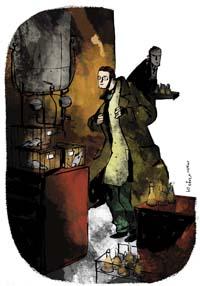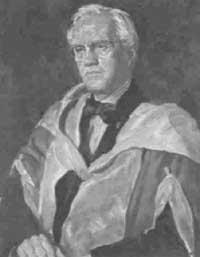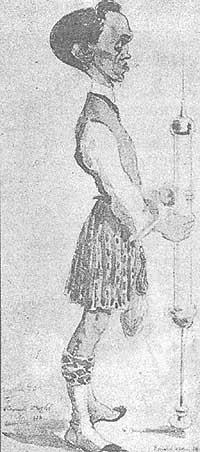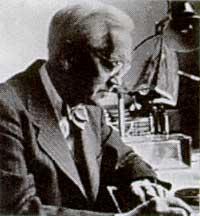The miracle of Lizun
2009/12/01 Etxebeste Aduriz, Egoitz - Elhuyar Zientzia Iturria: Elhuyar aldizkaria

"It seems like a miracle!" Dr. Florey said on hearing about the death of the four mice. Chain, for his part, began to dance and the rest of the group was very altered.
The previous day, May 25, 1940, the team of Howard Florey launched an experiment. At 11 a.m. on Saturday, eight mice were introduced into a dose of Streptococcus bacteria, and half penicillin. In 16 and a half hours, the four who did not receive penicillin were dead and the other four remained alive.
The Australian Howard Florey, son of an English shoemaker, had been in his father's hometown for 15 years. In Australia he studied medicine and, after serving as a researcher and professor, in 1935 he was the director of the Sir William Dunn School of Paty in Oxford. He soon began to form a large team of scientists. Despite not being very common at the time, Florey was clear that he wanted a multidisciplinary team of researchers.
Among the first members of the group were his wife, Ethel Florey, also studied in medicine in Australia, and the Jewish biochemist Ernst Boris Chain, who fled the Nazis.
Florey and Chain were men of live genius, sharp, who do not know how to yield. In this way they were collided many times, but it could not be said that they were molded badly. In the summer nights of 1938, on the way from work to home, the theme was the same: natural antibacterial substances.
When reviewing the scientific bibliography to carry out a systematic investigation of these substances, several examples were found. Among them was the penicillin that Scottish researcher Alexander Fleming found with fortune ten years earlier.
While reading Fleming's work, Chaini suddenly came the image of a girl. He reminded one of the employees of Dunn School, with a tray down the hall and moulds on the tray. Chain went to talk to her: "That lustful thing I have never seen... What is it? ". And when the girl pronounces "Penicillium notatum" Chain, "That's what Fleming found in 1928." "Yes, he gave us a sample and then we kept it alive."
The team started working with him. The biochemistry Norman Heatley began with enthusiasm the sowing and growth of molds. After the great headaches, Chain and Edward Penley managed to extract the ecpenicillin from Abraham. In the end they had that brown powder. It was very little, but the young Florey and Margaret Jennings could start testing on living things.
The experiment with eight mice made it clear that this dust could cure deadly infections. And that was almost a miracle at that time. Florey said they had to do tests immediately on a larger scale. "Keep in mind," he said, "that we must reach the human being. To achieve this, all this will be just a laboratory curiosity, as was the fungus of Fleming. And the man is 300 times greater than the mouse."
It was time of war, it was not easy to get the necessary resources, and all kinds of containers found in the area were used to cultivate mold: bottles, trays, boxes of biscuits, dishes... And they realized that the best containers for mold growth were the urinary ones of the hospitals.
At the end of June, 1940, tests with more mice were started. Florey and James Kent spent the day looking at the mouse and only slept a few hours in the laboratory. The substance was confirming its power.
Meanwhile, the German bombers were in the skies of England. The invasion was in everyone's head. And the scientists of the group made the decision to take in the head the secrets of the extraction if the worst and spores of mold occurred in the clothes. Florey rubbed the spores in the warm lining; Heatley in the pocket of the suit.
In January 1941, Ethel told the husband of a hospital patient: Albert Alexander, dying. After wounding with the thorn of a rose, the staphylococci and streptococci invaded the body. Florey put all the penicillin of his laboratories to heal this man. And the man improved remarkably. But they did not have enough penicillin and efforts to recover it from man's urine were not enough.
They had to produce penicillin on a much larger scale. But in England, destroyed by the bombings, Florey's team found no means for it.
On June 26, Florey and Heatley left Oxford. In the suitcase of the first one there were spores of mold and penicillin ampoules. They went to the United States to ask for help in producing penicillin.
The Americans looked for new fungi that would produce more penicillin and grow well in large tanks. The army pilots dispersed around the world were commissioned to bring molds from the places where their bases were. They got hundreds of new mushrooms, but did not improve the performance of Fleming.
Neighbors in the area were also asked to take the molds they found in wet shoes, corrupt fruits, cheese, bread, etc. Mary Hunt took this work more seriously than anyone and they called her Marilizu. In the summer of 1943, Marilizun found a new mold in a corrupt melon back of a fruitiness. This mold had a performance far superior to that of Flemingen. And the production skyrocketed.
The use of penicillin was spreading. Florey and his wife owned a long list of sick people cured with penicillin, which was also becoming an important weapon for Allied soldiers. Many wounds that previously caused death were recovered.
Penicillin has saved many lives since then. And that also worried Florey. In 1967, the year before his death, he said: "You can say I'm the culprit in part of a population explosion... that's one of the most destructive problems the world will have in this century."

Gai honi buruzko eduki gehiago
Elhuyarrek garatutako teknologia






